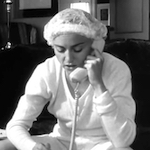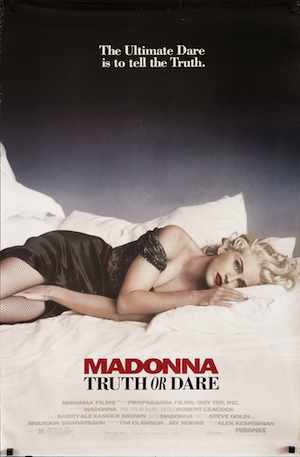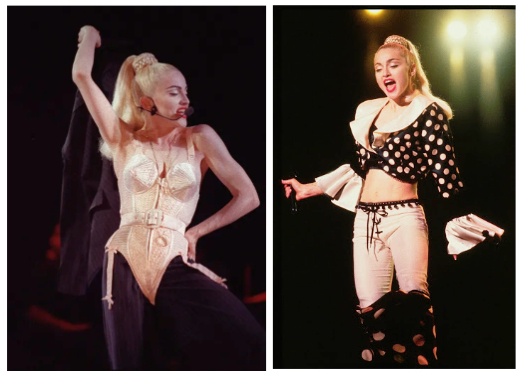 May 10, 1991
May 10, 1991
There were several movies in the summer of ’91 that were major pop culture events, widely discussed, referenced, parodied. One of them, surprisingly, was a music documentary shot mostly in 16mm black and white.
 Or really more of a tour documentary than a music documentary. One thing that’s unusual about MADONNA: TRUTH OR DARE is that it’s entirely about its subject being a performer, a troupe leader, and a celebrity, and not at all about her music, or even the creation of her show.
Or really more of a tour documentary than a music documentary. One thing that’s unusual about MADONNA: TRUTH OR DARE is that it’s entirely about its subject being a performer, a troupe leader, and a celebrity, and not at all about her music, or even the creation of her show.
The Blond Ambition World Tour was not a normal concert – it was more like an extravagant stage musical. On the four month, 57-show tour from Chiba, Japan to Nice, France, Madonna promoted her 1989 album Like a Prayer and 1990 DICK TRACY tie-in I’m Breathless, backed by seven dancers, two backup singers, an eight-piece band and a $2 million, 80 x 70 foot stage set that was hauled in 18 trucks and set up by over 100 crew members. Every song we see in the movie has its own backdrop, wardrobe (by the fashion designer Jean-Paul Gaultier – or, as we know him, the guy who did the costumes for THE FIFTH ELEMENT – who Madonna recruited in 1989 by sending him a nice letter) and complex choreography. When the movie begins they already seem like old pros at performing it. If there’s drama about something going wrong it’s not any of them messing up. It’s the sound system or the weather.
We don’t even see much rehearsing, and so little attention is paid to the people playing the music that pretty late in the movie there was a clear shot of them with their instruments and I thought, “Oh, that’s who those guys were.” The people we see most of are the dancers – who Madonna likes to consider herself a mother figure to – plus the hair and makeup people and a guy I assume is the road manager.
 Though not explained in the movie, the show (art directed by Madonna’s brother Christopher Ciccone) was divided into five thematic segments, one of them inspired by Fritz Lang’s METROPOLIS, another by Warren Beatty’s DICK TRACY. The latter, as far as I could tell, is left out of this movie – we don’t get to see the part where she had a dancer in the Dick Tracy yellow hat and overcoat. We do see Beatty himself in a few backstage scenes, because Madonna was dating him during part of the tour.
Though not explained in the movie, the show (art directed by Madonna’s brother Christopher Ciccone) was divided into five thematic segments, one of them inspired by Fritz Lang’s METROPOLIS, another by Warren Beatty’s DICK TRACY. The latter, as far as I could tell, is left out of this movie – we don’t get to see the part where she had a dancer in the Dick Tracy yellow hat and overcoat. We do see Beatty himself in a few backstage scenes, because Madonna was dating him during part of the tour.
Those scenes were among the most famous, not just because of the gossipy appeal of two ultra-famous co-stars of different generations being together, but because Beatty is the only person who seems to question his girlfriend asking a camera crew to intrude in her life. In his first scene he hangs out backstage, awkwardly standing around with his hands in his pockets or sitting on a couch with a glass of wine while she holds court in her makeup chair, trying to get him to come over. He seems bemused by the whole thing, which he confirms in a later scene when he asks her whether anyone has told her that “this” (the movie) is crazy. No, no one has told her that.
“She doesn’t want to live off camera, much less talk,” he says. “There’s nothing to say off camera, why would you say something, if it’s not on camera?”
 So this pretty much marks the beginning of the time when we as a culture were fascinated with the fact that we as a culture were fascinated with voyeurism and exhibitionism. The first season of The Real World aired on MTV about a year later, and we’ve yet to turn back. (After screening an early cut in his home theater, Beatty got her to remove some of his scenes by threatening to sue.)
So this pretty much marks the beginning of the time when we as a culture were fascinated with the fact that we as a culture were fascinated with voyeurism and exhibitionism. The first season of The Real World aired on MTV about a year later, and we’ve yet to turn back. (After screening an early cut in his home theater, Beatty got her to remove some of his scenes by threatening to sue.)
There are a few other celebrity cameos – she hates Kevin Costner because he dorkily tells her the show was “neat” – but the biggest one is late in the movie after her pal Sandra Bernhard asks her if there are any celebrities she still wants to meet, and all she can think of is “the guy who’s in all of Pedro Almodovar’s movies.” In Spain she gets to go to an event held by Almodovar, where she indeed meets Antonio Banderas. He’s very nice to her and also very uncomfortable since she makes it clear to everyone including his wife that she didn’t know he was married and is bummed that she won’t get to fuck him.
After the scene she says in voiceover, “I never heard from Antonio again.” Of course, five years later they starred in EVITA together. By that time Banderas had already met Melanie Griffith, who he left his first wife for, so I’m not sure Madonna was able to get in there. You can’t have it all, material girl.
Throughout the movie it will switch to 35mm color and smooth crane shots for the performances, the camera always close to the front of the stage or on stage looking out, so that we feel more the perspective of the performers than the audience. But anything off stage – most of the movie – is 16mm black and white, shot more guerrilla style. Both formats look stunning on the blu-ray. There are six directors of photography credited, different people in different stretches of the tour, but for the documentary stuff shot in Houston it was Daniel Pearl. Makes sense, because he had been one of the top guys for music videos for about a decade, but this handheld stuff must’ve brought him back to his TEXAS CHAIN SAW days a little bit.
The French New Wave sort of look and some of the situations they show Madonna in work together to humanize her. Yes, she is the MADONNA, the same one being worshipped on that enormous stage in full color, and when she’s not there or backstage being waited on by her loyal staff we mostly see her living a privileged life lounging in her bathrobe in fancy hotel suites, having cocktails, sometimes wanting to be alone(ish). (We don’t see her in public being mobbed by fans until she gets to Europe, giving the impression of a reverse-Beatlemania.)
But we also get a glimpse of the regular-person-turned-superstar – she slurps on a bowl of soup while calling her dad to try to find out if he’s coming to the show or not; she seems wary about seeing her just-out-of-rehab brother, but then very hurt when he fucks around and doesn’t come to the hotel to see her when he’s supposed to. So she goes to bed and we see the sad sight of him timidly tapping on her hotel door, not getting an answer, then slinking away in an elevator-ride-of-shame with all his hangers-on who didn’t get to meet Madonna.
In another scene she’s really excited to see a neighborhood friend from childhood, but only has a minute to say hi to her, and the friend tries to fit into that window a request to be godmother to her child. I felt so bad for both people in this conversation – it’s so inappropriate in the moment, but there’s this power imbalance there and that poor lady’s trying to take her shot with someone who was important to her youth who she probly can’t just call on the phone.
There are many instances when Madonna comes off looking badly. Right at the beginning she has a problem with a monitor during a sound check and without even first trying to ask politely she says, “I’m waiting.” That’s normal brat behavior though – a weirder one is when she uses her traditional pre-show group prayer with the dancers to lecture them about their “behavior,” also invoking the memory of a recently deceased friend she’s dedicating the show to (who turns out to be Keith Haring) to make them feel bad. I mean it’s a perfectly appropriate airing of grievances/pep talk, but don’t put it in the form of a prayer! That’s unethical! “Oh, I’m sorry, did you overhear what I said and know I was criticizing you? I was talking to God.”
But I still ended up liking her. Despite what is clearly a superhuman discipline in creating this performance, she seems fun, and genuinely loving to her crew. There’s a scene where they have a birthday party for her assistant and she reads a poem she wrote about her. It’s long and funny, seems to absolutely delight everybody crammed into the room, and obviously required alot of time and thought. I can’t imagine how it would feel to be in a room full of friends and family and someone is paying tribute to you like that and it’s 1991 and that person is Madonna! I mean, she was Breathless Mahoney. Admit one.
The moves in “Express Yourself” really reminded me of Michael Jackson. I looked it up and sure enough the tour’s choreographer/director Vincent Patterson was one of the two fighting dancers in the “Beat It” video, and a zombie in “Thriller,” and he choreographed “Smooth Criminal,” “Black or White,” ”The Way You Make Me Feel,” “Dirty Diana,” “Speed Demon,” the Bad tour and MJ’s performances at the Super Bowl and Grammys. So yeah, you could say he knew a little bit about Michael’s moves. Including lots of crotch rubbing and ground humping.
But it’s “Like a Virgin,” where she rolls around on a red velvet bed wearing Gautier’s famous corset with conical bra, that raised the most eyebrows. I forgot all about this, but the “simulated masturbation” of caressing her crotch and humping the bed was a major controversy back then, and within the movie. Cops in Toronto warn that she might be arrested afterwards if she does it. There’s a bunch of excitement and feelings of mischievous rebellion as word gets around backstage and she says to tell them she won’t change her show because “I am an artist and this is how I choose to express myself.”
I like when her road manager or whoever tells the cops that Madonna has already performed this show to acclaim all around the world and “I’m sure it will be an international scandal” if they arrest her. And when the movie shows her performing the song (likely not even shot that same night, I imagine) her hand keeps hovering near her crotch suspensefully – is she gonna do it? Of course she is.
But in the end nothing happens. The cops say there was a complaint about the show but they checked it out and it was nothing. I wonder if they just couldn’t get tickets?
This is a theme throughout – the idea of people being uptight about the sexy stuff and Madonna and company taking umbrage that it violates the ol’ freedom of speech and what not. When she warns her dad “It gets pretty racy” and he asks if she could tone it down for him she says, “No, because I would be compromising my artistic integrity.” It seems rote, just a thing she says. But when she’s in Italy there’s some kind of brouhaha with the Vatican, so she has a huge press conference and code-switches to her Very Serious Orator voice to read an impassioned statement about being proud to be an Italian-American and believing in free speech and how the show “asks questions” and “the audience is left to make its own decisions and judgments.” All this stuff comes off as silly and pretentious, and also completely correct. I was never a big Madonna fan, I chuckled at the golden pointy bras like everybody, but looking at it now, this shit is cool! It’s a great performance. She knows what she’s doing. This must have been an amazing thing to witness.
As an older person I’m more keenly aware of how hot she is in the movie, but many of the things that were considered so provocative back then seem like not much. I mean, sure, the title-explaining scene where she happily accepts a dare to demonstrate her b.j. skills on a bottle is a little much, but her dancing around in shiny lingerie, it honestly seems natural. What’s she gonna do, wear pants the whole time? That would be stupid. She seems much more powerful in the underwear than when she wears that polka dot outfit with the flares, I’ll tell you that.

Okay, to be fair, I guess she is wearing pants at that point.
This film was also ahead of its time in presenting the lives of gay men in a widely seen movie. There’s certainly a bit of a patronizing vibe to how she presents herself as their champion/mom, but also
1) I think it’s safe to say that her work did help to push aspects of gay culture into the mainstream and
2) they clearly adore her.
Come to think of it, Bernhard’s scene also has her talking about the women she’s dating, so there’s some visibility for lesbians in there too.
But it actually spends the most time with a dancer named Oliver who (although I didn’t realize it at first) is the only straight one on the tour. He’s definitely dealing with some homophobia (he makes a show of leaving during the titular game, when men kiss and a dick is exposed). But he has the most interesting drama in his life: he reunites with his estranged father, who accepts that he can be a dancer now that fucking Madonna hired him; a tabloid claims that he’s Madonna’s new lover, and he seems to fear that he only got the job because she thought he was hot.
There’s actually one part of the movie that I did find genuinely shocking, and that I’m embarrassed to say I didn’t even remember. In a quick little segment, we hear that one of the makeup artists, Sharon Gault, went out dancing without anyone else from the tour, and then woke up in her room. I won’t repeat the details, but it’s indicated that she was drugged, raped and robbed. When Madonna hears the story from someone else she doesn’t react the way you’d wish she would, and when Gault tells the story herself she downplays it, turns it into self deprecation, like “silly me, can you believe I put myself in that situation?” Says she learned her lesson not to go out without somebody else from the tour. As far as we’re shown in the movie nobody really treats it more seriously than that, or offers her much support, or talks about going to the police or anything like that. And then it moves on to the next thing. It’s very upsetting.
(Gault went on to a long career doing makeup for Michael Jackson, Miley Cyrus and Lady Gaga, but has had alot of hardship in recent years, according to a fundraiser that said she was homeless.)
MADONNA: TRUTH OR DARE was distributed by Miramax, but produced by Propaganda Films, and funded by Madonna herself so that she could, you know, express herself. According to Vulture’s recent oral history of the movie, when Harvey Weinstein started to talk to her after a test screening she told him that she didn’t care what he thought and never wanted to hear another one of his ideas about it again.
Propaganda was a production company founded in 1986 by producers Steve Golin and Sigurjon Sighvatsson and music video directors David Fincher and Dominic Sena. Though the intent was always to produce movies, they ended up putting much of their focus into videos and commercials, and acting as a talent management company for their directors. They helped launch the careers of future filmmakers including Michael Bay, Spike Jonze, Michel Gondry, Mark Romanek, Antoine Fuqua, Gore Verbinski, Alex Proyas, Simon West and Zack Snyder.
By 1991 the company had produced several movies, including John Dahl’s KILL ME AGAIN and Todd Solondz’s FEAR, ANXIETY & DEPRESSION. They had recently worked with David Lynch on Twin Peaks and WILD AT HEART.
Fincher – who had directed Madonna’s videos “Express Yourself,” “Oh Father” and “Vogue” – was originally set to direct what was planned as an HBO concert special, but dropped out shortly before the tour began. (That would’ve been pretty much exactly when he replaced Vincent Ward on ALIEN 3.) So instead they got 26-year-old Alek Keshishian, who had directed videos for Vanessa Williams, Bobby Brown, Taylor Dayne and Elton John, plus a student film that Madonna loved. Brought to Japan for the first show, he was curious about the lives of the dancers, so he shot some interviews. He showed the resulting footage to Madonna, arguing that a feature film showing her relationship with the dancers backstage would be better than an HBO concert special. To the horror of her manager and publicist, she agreed.
It’s kind of hard to explain what a big deal this movie was at the time. I guess I was at a prime MTV-watching/magazine-reading age around then, but it seemed like you just heard about it constantly. Obviously some of the attention came from such a major star being openly sexual in a time before celebrity sex video leaks and unlimited porn access at the push of a button, but that doesn’t account for all of it. It was one of the most mainstream, universal pop stars in the world, but it seemed genuinely edgy, arty and controversial. I knew Madonna’s hits and I think I respected her, but I was never really into her, never bought an album or anything. Still, I saw this. On video, but when it was new. You had to see it for yourself. It seemed like something important.
In the U.S., TRUTH OR DARE opened in limited release on May 10th, making it to #13 on the box office charts while only playing 51 screens. On the 11th, Madonna appeared on Saturday Night Live, parodying the movie (and the “Justify My Love” video) in a black-and-white Wayne’s World segment. I feel this is important to mention because my dad thought it was hilarious and frequently quoted the line, “Wow, look at the unit on that guy!”
SNL Short Wayne’s World & Madonna – Justify My Love from His Dudeness on Vimeo.
When the movie went wide on the 24th it moved up to #3, which is pretty impressive for a mostly black and white documentary. Not adjusted for inflation it outgrossed WOODSTOCK. It played for 33 weeks and held the record as the highest grossing documentary of all time for more than a decade (it was surpassed by BOWLING FOR COLUMBINE in 2002).
I remember there being lots of hype in movie magazines and stuff about Keshishian being the hot new director, kinda like Steven Soderbergh was a little before that. He says he was offered every musician documentary in the world, but didn’t want to repeat himself or feel it was possible for anyone else to make “their TRUTH OR DARE.” After the Brendan Fraser movie WITH HONORS (1994), Keshishian stuck to directing commercials for more than a decade. His only film as a writer director to date is LOVE AND OTHER DISASTERS (2006) starring Brittany Murphy, but he did reunite with Madonna in 2011 to co-write W.E., her second movie as a director. (She’s only directed one less than he has.)
Unfortunately, three of the dancers sued over the film. They said they weren’t paid what they were owed, and that they were told they could request to have anything they wanted cut out, then were bullied out of it when they tried to. It was ultimately settled out of court. Keshishian and Madonna seemed to think the suit was opportunistic and a betrayal, that the dancers had signed waivers and knew what they were getting into. But clearly this was an unusual request sprung on them well into a gig they’d have to be crazy to give up (remember, the behind-the-scenes idea wasn’t even conceived until the tour was already in progress) and it’s not like they could’ve fully understood what the movie would be like or how many people would see and hear about it.
In recent years Madonna has said she’s afraid to watch the movie, that she thinks she was a brat. Which is true. But I think it holds up really well as an entertaining look at an unusual life at a particular moment in time. And it’s only one of the movies this summer that will strike a chord by portraying women as powerful in ways we weren’t used to.



























May 11th, 2021 at 1:00 pm
Kevin Pollak did a spoof of the prayer circle scene on an HBO special, where during the prayer he fired someone.
I remember seeing Harvey Weinstein on television for the first time on her BEHIND THE MUSIC, when they talked about the scene where she said Sean Penn was the love of her life. She wanted it taken out but Weinstein basically said over his dead body. I came away from it almost jokingly thinking to myself what a creep this guy is.